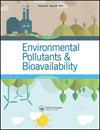天然沸石对绿色废弃物转鼓堆肥过程中重金属形态的影响
Q3 Chemical Engineering
引用次数: 17
摘要
摘要水葫芦堆肥中重金属的存在是制约其土地利用的主要因素。水葫芦可以在其组织中积累重金属。在水葫芦堆肥过程中应用天然沸石(斜沸石)可能有助于固定重金属。研究了水葫芦与牛粪、木屑和天然沸石混合堆肥过程中重金属(Zn、Cu、Mn、Fe、Pb、Ni、Cd和Cr)的形态。采用Tessier序贯萃取法测定重金属形态。将水葫芦、牛粪、锯末按6:3:1的比例与天然沸石按重量5%、10%、15%混合。研究了温度、pH、有机物降解等理化参数对重金属形态的影响。转鼓式堆肥机已被证明对有机物的降解非常有效。由于沸石的加入和金属与稳定的有机物质的络合作用,在旋转鼓中有机物的高度降解,生物利用度最高的部分(交换性和碳酸盐部分)显著减少。在可还原和可氧化组分中未发现镍、铅和镉。综上所述,在水葫芦转筒堆肥过程中,添加适量天然沸石显著降低了重金属的生物利用度。本文章由计算机程序翻译,如有差异,请以英文原文为准。
Influences of natural zeolite on speciation of heavy metals during rotary drum composting of green waste
Abstract The presence of heavy metals in water hyacinth compost is the main limiting factor for its land application. Water hyacinth can accumulate heavy metals in its tissues. Application of natural zeolites (clinoptilolite) during water hyacinth composting may be helpful to immobilise heavy metals. The present study was carried out on the speciation of heavy metals (Zn, Cu, Mn, Fe, Pb, Ni, Cd and Cr) during rotary drum composting of water hyacinth mixed with cattle manure, sawdust and natural zeolite. The Tessier sequential extraction method was used for heavy metal speciation determination. The water hyacinth, cattle manure and sawdust at a ratio of 6:3:1 ratio was mixed with 5, 10 and 15% natural zeolite by weight. Influences of physicochemical parameters such as temperature, pH and organic matter degradation on speciation of heavy metals were studied during the process. A rotary drum composter has been shown to be highly efficient for organic matter degradation. The most bioavailable fractions (exchangeable and carbonate fractions) were reduced significantly due to the combined effects of zeolite addition and metal complexing with stabilised organic matter as a result of the high degradation of organic matter in a rotary drum. Ni, Pb and Cd were not found in the reducible and oxidisable fractions. Overall, the addition of an optimum quantity of natural zeolite significantly reduced the bioavailability fractions of heavy metals during rotary drum composting of the water hyacinth.
求助全文
通过发布文献求助,成功后即可免费获取论文全文。
去求助
来源期刊
CiteScore
1.62
自引率
0.00%
发文量
0
审稿时长
1 months
期刊介绍:
Chemical Speciation & Bioavailability ( CS&B) is a scholarly, peer-reviewed forum for insights on the chemical aspects of occurrence, distribution, transport, transformation, transfer, fate, and effects of substances in the environment and biota, and their impacts on the uptake of the substances by living organisms. Substances of interests include both beneficial and toxic ones, especially nutrients, heavy metals, persistent organic pollutants, and emerging contaminants, such as engineered nanomaterials, as well as pharmaceuticals and personal-care products as pollutants. It is the aim of this Journal to develop an international community of experienced colleagues to promote the research, discussion, review, and spread of information on chemical speciation and bioavailability, which is a topic of interest to researchers in many disciplines, including environmental, chemical, biological, food, medical, toxicology, and health sciences.
Key themes in the scope of the Journal include, but are not limited to, the following “6Ms”:
Methods for speciation analysis and the evaluation of bioavailability, especially the development, validation, and application of novel methods and techniques.
Media that sustain the processes of release, distribution, transformation, and transfer of chemical speciation; of particular interest are emerging contaminants, such as engineered nanomaterials, pharmaceuticals, and personal-care products.
Mobility of substance species in environment and biota, either spatially or temporally.
Matters that influence the chemical speciation and bioavailability, mainly environmentally relevant conditions.
Mechanisms that govern the transport, transformation, transfer, and fate of chemical speciation in the environment, and the biouptake of substances.
Models for the simulation of chemical speciation and bioavailability, and for the prediction of toxicity.
Chemical Speciation & Bioavailability is a fully open access journal. This means all submitted articles will, if accepted, be available for anyone to read, anywhere, at any time. immediately on publication. There are no charges for submission to this journal.

 求助内容:
求助内容: 应助结果提醒方式:
应助结果提醒方式:


